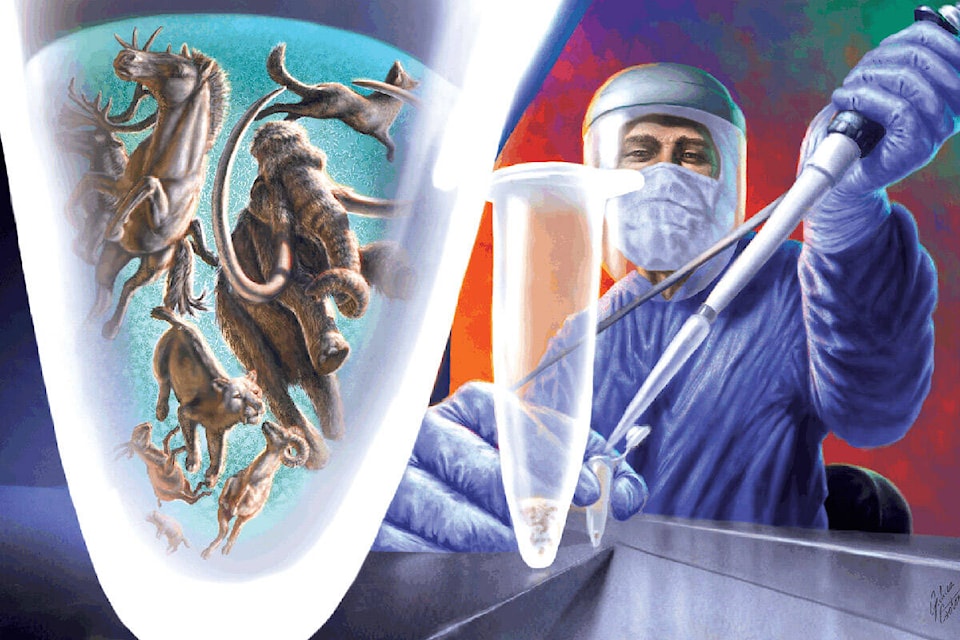A new study examining ancient DNA from the Yukon is changing the timeline for when woolly mammoths and ancient horses roamed the continent.
Tyler Murchie, a researcher at the McMaster Ancient DNA Centre in Hamilton, was the lead author on a new paper in the journal Nature on Dec. 8, with new evidence that suggests ancient horses and mammoths may have roamed the Yukon landscape up until 6,000 years ago.
“This [increasing DNA evidence] highlights that the Pleistocene-Holocene transition was perhaps more drawn out than fossil records indicated,” said Murchie, during a talk hosted by the Bergenia Centre on the new research.
The existing fossil record has assumed that both horses and mammals had a massive die-off in the Yukon and Alaska around 15,000 years ago. But that assumption is based on large “macrofossils” to provide DNA.
Large fossils are rare and limited to specific areas because of environmental and human-specific factors. But new methods of tracking species through tiny fragments of environmental DNA could provide a larger picture.
“While the Yukon does have an exceptional fossil record because of permafrost, the number of specimens that are found is still only a tiny fraction of animals that ever lived in that area. When talking about potential refugial populations after the Pleistocene-Holocene transition, it’s even more unlikely that we’d be able to find the bones of those last few remaining animals. Whereas they would still leave behind an immense amount of environmental DNA throughout their lives and we need to find the right places to look for that,” said Murchie.
For this study, Murchie and his ancient DNA colleagues examined core samples of permafrost from four placer gold mine sites in the Klondike, including Bear Creek, Upper Goldbottom, Upper Quartz and Lucky Lady.
In just 250 milligrams of ancient sediment – a sample size of about a teaspoon – the researchers were able to identify and date bits of DNA from a wide swath of ancient species, including horses, bison, mammoths, ravens, ptarmigan and Beringia carnivores.
“We found a huge diversity of plant and animal DNA,” said Murchie.
The sample revealed both the density of animals and plants. Side-by-side, researchers were able to compare how animal populations shifted as the landscape changed.
Around 30,000 to 13,500 years ago the Yukon was a very different place. The landscape, described as the mammoth-steppe, was an ancient prairie-like environment dominated by grasses, short shrubs and flowering herbs.
Around 13,500 years ago the landscape began to transition towards denser and woodier plant life, eventually becoming the boreal forest we’re familiar with today.
The research published in Nature focused on horses and woolly mammoths, two relatively common herbivore species in ancient Beringia. Widely thought to have disappeared along with the steppe, it turns out they may have been common in the ancient Yukon and Alaska for much longer than scientists originally thought.
“These results are mind-blowing, they’re earth-shattering,” said Yukon paleontologist Grant Zazula. “They really change the system in terms of what we understand about the Holocene and the Pleistocene.”
“The fact that these mammoths and horses now survive into the Holocene really confirms that it was not an instantaneous event where everything got wiped out at once. Thinking about it in the wider Yukon context, especially in terms of archeology and what we know about First Nations people, this really opens up an amazing conversation about First Nation relationships with these animals during the Holocene,” said Zazula.
Aside from a couple of very isolated finds, large fossils that preserve mammoth DNA from the boreal forest period have not been found. This evidence has helped contribute to the current idea of when they disappeared. But Murchie’s sample indicates a “late survival or ghost range signal” that suggests the presence of their DNA past the point of the large fossil record.
Murchie’s data joins other recent studies suggesting later survival records. Research using environmental DNA instead of fossils is still new, and more work is planned to confirm the results more widely. The potential for a later timeline might also have researchers taking a second look at existing evidence.
“More research is definitely needed from more sites to confirm and explore this mid-Holocene signal,” said Murchie.
Paper co-author Hendrik Poinar compared the use of environmental DNA to early forensic science research. Use of DNA evidence was once treated with skepticism, but as the field emerged and methods were fine-tuned, it has become almost an unquestioned tool in solving crime.
“Environmental DNA is in its infancy in terms of the methods used, and we’re just learning this stuff now. We’re going to build on this,” added Zazula.
Large fossils will continue to be the gold standard of evidence, but environmental DNA is more accessible than large fossils, and it could open up other old scientific assumptions about ancient beringia.
For example, it could complicate the polarized debate between researchers who believe climate change or human hunting led to mammoth extinction.
There’s also the possibility that ancient horses never fully disappeared from North America, or that humans and mammoths existed side-by-side for much longer than the fossil record suggests – two possibilities that could be supported by oral history.
The answers to that question could be locked in the permafrost of the North – but as climate change disrupts that land, Murchie noted that the work is even more urgent.
“Given that the Arctic is warming faster than the rest of the planet, these genetic archives themselves are at risk of permanently disappearing,” said Murchie. “With these thawing sediments will go all the life history data that has been cold-preserved at a micro-scale for millennia.”
Contact Haley Ritchie at haley.ritchie@yukon-news.com
